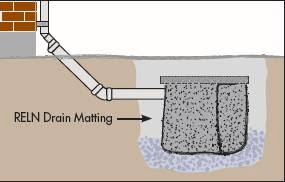What is a Soakwell?
A soakwell (also known as a drywell or dry well) is an underground structure that disposes of unwanted water, most commonly surface runoff and stormwater, and in some cases, greywater. It is a covered, porous-walled chamber that allows water to soak into the ground slowly (that is, percolate), dissipating into the groundwater. Soakwells are known as soakaways in the United Kingdom or soak pits in India.

Perth Soakwells are usually made of concrete, polypropylene or masonry bricks. Typically, rainwater from a dwelling roof or impermeable ground area travels via stormwater piping to a soakwell or underground tank, gently seeping into the surrounding soil. Soakwells are mostly connected to downpipes leading from gutters on practically most outdoor habitations unless a common drainage system is available.
In the past many homeowners installed soakwells by digging a hole and building it out with bricks and mortar, however, this system often allow leaching of sand back into the soakwells
A soakwell can range in size from a few litres to 5000 litres in concrete or extended volumes in polypropylene. A soakwell is installed typically 300mm to 500mm below ground with the bottom edges varying in depth between 900mm to 2.4 metres.
Why Do We Need Soakwells?
Forgetting the fact that managing rainwater on your property is a legal requirement in Western Australia, it makes no sense to cut corners with your soakwell system.
When a volume of rainwater arrives, you need the confidence that your soakwells will perform as required.
Rainwater, which is not effectively managed on your property, can cause a range of issues. Apart from the apparent effects of erosion on your property and your neighbours, a build-up of water against your property can cause many problems, including:
- Erosion of house stumps and building subsidence
- Subsidence of footings and concrete pads
- Rising damp to walls and foundations and flooring
- Wood rot
- And let’s not forget termites love a drink and you could be the principal provider
Unless you effectively manage rainwater on your property, you could be faced with carrying out extensive repairs and renovations to your home, both inside and out, above and below.
However, if you install a soakwell system which is designed to accommodate the expected levels of rainwater for your property, you are likely to avoid significant maintenance costs and avoid issues with your neighbours.
How does a Soakwell Work?
When rain falls on undeveloped property, it’s evenly distributed across the soil, where it will later disperse. The introduction of non-porous structures like roofing, foundations, and paving prevents the even dispersal of rain, which leaves the bare soil around those structures to absorb much more water than it would in their absence. This can contribute significantly to problems like soil erosion and flooding while also presenting a risk of foundation damage.

Soakwell installation is one of the most commonly relied-upon methods of preventing water damage related to flooding. Soakwells work by collecting rainwater diverted through pipes and dispersing it into the soil. They’re installed underground, and come in a variety of sizes.
I want to install Soakwells as i am constructing new house with Ventura homes .Th ehouse size is 300 sqm total roof area.So wanted a quote for soak well supply and
install as its not included in my construction contract
We can definitely help you out with the Ganesh – we specialise in new home soakwell installations. We sent you an email the day after we received your inquiry, but please let us know if you need any further assistance.